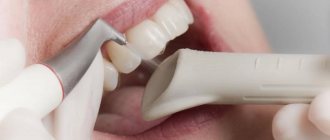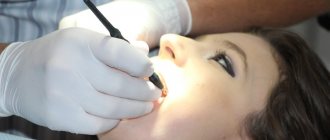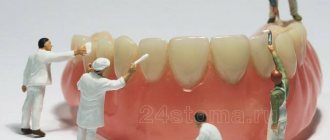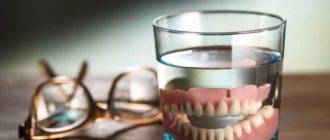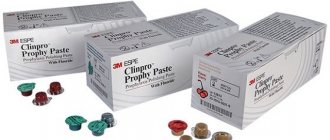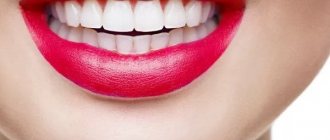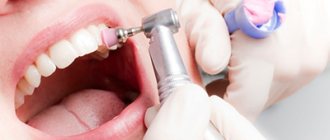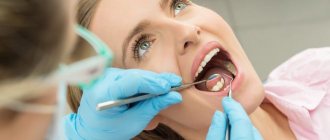- Hygienic teeth cleaning
- When is the best time to have your teeth professionally cleaned?
- Comprehensive professional teeth cleaning
- Professional teeth cleaning with ultrasound
- Cleaning teeth from plaque using the Air Flow method
- What is laser teeth cleaning?
- Manual teeth cleaning how the procedure is done
- Preventative care after comprehensive cleaning
- How and what to brush your teeth at home
- Our doctors
Plaque forms in the mouth due to harmful bacteria. If you do not take the necessary measures, this provokes the formation of tartar and the development of caries. Gum pathology may develop, leading to loosening and then tooth loss. To take care of their hygiene and health, professional hygienic teeth cleaning is necessary. To do this, it is worth visiting a dental clinic in Moscow.
The procedure effectively removes plaque, returns teeth to their natural white color, and prevents caries and gum disease. Professional care differs from home care in that the dental hygienist works with special tools. Plaque removal can be done in hard-to-reach places that a regular brush or even expensive toothpaste cannot do. The enamel layer is lightened by 1-2 tones, acquires a white color and a healthy appearance.
Deep hygienic dental cleaning prevents periodontal disease, damage to teeth by caries, their mobility, and loss.
When is the best time to have your teeth professionally cleaned?
You can tell when it’s time to see a doctor based on the following signs:
- an unpleasant putrid odor appeared from the mouth;
- the gums began to bleed, their subsidence was noticeable;
- itching or burning appears, pain is possible, especially when chewing food;
- tartar is visible visually;
- the color of the periodontium has changed.
Professional teeth cleaning will not harm your health, but there are contraindications:
- diseases of stomatitis, hepatitis, tuberculosis, as well as the presence of acute infections;
- the patient’s tooth enamel is too thin;
- intolerance to components used in cleaning;
- erosion, hypoplasia of tooth enamel.
Dental hygiene should not be done if the patient is under the age of eighteen. Professional hygiene is also contraindicated for HIV-infected people and AIDS patients. If there are diseases associated with difficulty breathing (asthma, epilepsy), sandblasting should not be carried out.
How often should I clean?
Dentists have a unanimous opinion on the issue of frequency of teeth cleaning. The procedure should be performed 1-2 times a year, but not more often, so as not to damage the enamel.
It is necessary to take into account the individual characteristics of the body - for some it is enough to clean the stone once a year, while for another person plaque formation occurs faster, and he needs to visit the dental clinic once every six months.
In addition, professional teeth cleaning is indicated before prosthetics, implantation and dental treatment, as well as before teeth whitening. A clean tooth surface will allow the dentist to do his job better:
- better choose the color of the filling, crown or veneer;
- notice the onset of caries in time;
- prevent many gum diseases;
- achieve good treatment and whitening results.
This manipulation is recommended for those people who smoke and often drink drinks with dyes (tea, coffee, wine, etc.).
Comprehensive professional teeth cleaning
The hygienic procedure is carried out using various professional methods. In a dental clinic in Moscow, the professional technique is individual for everyone. Regardless of the choice, the procedure is carried out in several stages:
- The dentist examines the patient's oral cavity. Based on the examination, a treatment plan is drawn up. If teeth cleaning is needed, the types and methods are determined by the hygienist.
- Chemical cleaning and removal of soft plaque with a professional toothbrush is performed.
- Removing hard plaque depends on the professional method chosen.
- The dentist uses dental strips to clean the sides of the teeth and polish them.
- The enamel is polished on all sides, all irregularities are eliminated. For this purpose, dentistry uses special brushes and professional cleansers.
- Deep cleaning of teeth is completed by applying a solution containing fluoride to the surface. The composition is applied briefly. Professional fluoridation strengthens the enamel, since it is weakened by the action of tartar. Teeth should be fluoridated to reduce their sensitivity and to prevent caries. Fluoridation can be done as a separate procedure.
After the hygiene procedure, the dentist gives the patient recommendations for professional oral care. This allows the effect to last longer.
Standard method of brushing teeth Pakhomova G.N.
This method is recommended by most Russian dentists. It was invented by G.N. Pakhomov - professor of dentistry.
- Cleaning begins from the upper jaw in the following order - from the right molars to the front ones, then finishes on the left molars.
- On the lower jaw, the left major ones are cleaned first, then the anterior ones, and lastly the right molars.
- The front and back surfaces are cleaned with sweeping movements from bottom to top, with the brush head at an angle of 45° to the gum.
- It is important to make 10 movements for each tooth.
- Contaminants from the chewing side are removed by moving the head back and forth.
- To clean the front teeth, the brush is placed vertically and moved in a sweeping motion.
The Pakhomov method helps to effectively clean the oral cavity, but for the interdental spaces additional means are needed - irrigators, threads and a tongue scraper.
Professional teeth cleaning with ultrasound
If you influence tartar with ultrasonic waves, the process of getting rid of it becomes quick. The advantage of the ultrasound method is its antimicrobial and antibacterial effects.
Ultrasound is safe. Professional attachments are put on the emitter. They effectively remove plaque even in hard-to-reach areas. The result is exfoliation of tartar and its partial destruction. This is relevant when removing it from gum pockets - their treatment with an instrument can be painful and traumatic.
Thanks to ultrasound, such professional teeth cleaning guarantees a gentle effect on tooth enamel.
The hygienic procedure begins with exposure to an ultrasonic scaler at an angle. High frequency vibrations of ultrasonic waves remove deposits from the surface. At the same time, a flow of liquid is supplied. Together with ultrasonic vibrations, plaque and stone remains are washed away from periodontal pockets and interdental space. Hard tissues are lightened.
One session is enough to remove hard and soft deposits. Ultrasound teeth cleaning has almost no disadvantages. Exceptions to the effects of ultrasound - several contraindications:
- the presence of a pacemaker, severe cardiovascular disease or acute renal and hepatic failure in the patient;
- significant demineralization of tooth enamel;
- Ultrasonic teeth cleaning is prohibited if there is caries, which manifests itself in the form of multiple destructions;
- purulent diseases of the oral mucosa;
- the presence of orthopedic structures, especially metal ones.
Ultrasonic teeth cleaning has advantages:
- the versatility of the method, which allows ultrasound to remove deposits even in hard-to-reach places;
- antibacterial effect;
- no discomfort or pain during professional cleaning.
Teeth cleaning methods
There are different methods of cleaning teeth. The standard method for brushing teeth is:
- Apply a small amount of paste to a clean brush;
- clean the upper jaw from the outside from the gums to the edge, starting from the farthest ones;
- clean your teeth from the inside with sweeping movements;
- clean the lower jaw in the same way;
- clean your tongue from root to tip (we recommend reading: how and how to properly clean your tongue from plaque at home?);
- clean the interdental space with floss;
- rinse your mouth with mouthwash.
The standard method is the best for brushing your teeth.
You can clean your teeth in any condition using the standard method. Other methods of teeth cleaning used in dentistry:
- The Leonardo method allows you to clean the oral cavity without damaging the gums. Moving the brush from the gum to the edge, clean the enamel from plaque. Hold the brush perpendicularly. With the jaws closed, clean the outer surfaces, and with the jaws open, clean the inner surfaces.
- Using the Bass method, the cervical area of the teeth is thoroughly cleaned. The brush should be positioned at an angle of 45 degrees to the surface. Clean with vibrating movements.
- The Fones method differs in that cleansing occurs with circular movements of the brush. It is not recommended to use this technique if you have gum disease.
Cleaning teeth from plaque using the Air Flow method
Unlike the ultrasonic method, Air Flow is the effect of air flow together with an abrasive on hard plaque. The abrasive material is soda, which is applied along with a thin stream of water. Adding menthol or lemon flavors to water gives a refreshing effect. Small particles of soda hitting the enamel due to the air flow do not harm the teeth. They effectively cope with soft and hard plaque in gum pockets and interdental spaces.
Brushing your teeth with water reduces the heating of enamel during the hygiene procedure. This professional method helps in effectively removing plaque and tartar, and thoroughly polishes the enamel.
In addition to being used as a comprehensive approach, air brushing is suitable in the following cases:
- implants, crowns, and other orthodontic structures are installed in the mouth, as well as if braces or implantation are to be removed;
- problems with gums at the initial stage or there is plaque that has not yet turned into tartar;
- severe pigmentation of teeth due to smoking, coffee abuse and foods with dyes.
The professional Air Flow technique is safe and painless, has a gentle effect, and cannot cause an allergic reaction.
If preventive teeth cleaning is not carried out as part of a comprehensive procedure, the effect will be short-lived. For a more lasting result, it should be done about four times a year.
Stage No. 3. Removing soft deposits using Air-Flow
Doctors say that it is brushing teeth using the Air-Flow water-abrasive technology that makes it possible to lighten the enamel by 1-2 tones and polish it. Don't believe me? See before and after photos. The result is obvious! "Air-Flo" fights soft pigmented deposits formed after eating food and drinks with dyes, with a smoker's plaque. After the procedure, the teeth acquire their natural shade, become smooth and shiny.
The photo shows teeth before and after cleaning with the Air-Flow system
The procedure can be performed without ultrasound, but when combined with it, it is much more effective. To carry it out, you need a device into which a special fine soda-based powder is filled, as well as water. While performing Air-Flow, some patients report a feeling of slight coolness in their mouth. After Air-Flo, the unpleasant odor disappears, and your breath becomes fresh, since the powder contains different flavors (mint, cherry, peach, lemon).
Read the article on the topic “6 interesting facts about Air-Flow whitening.”
What is laser teeth cleaning?
Laser therapy is based on the evaporation of liquid from plaque and deposits with a laser, after which the stones are destroyed layer by layer.
Hygienic laser cleaning does not involve contact of instruments with oral tissues. The professional technique is completely painless and has an antiseptic effect. The likelihood of an infection being introduced is zero.
Laser cleaning of teeth from stone gives the enamel a white color. Professional work effectively helps fight pathogenic bacteria and promotes wound regeneration. Prevention of caries is an additional advantage of the procedure. Contraindications to it are severe infectious and viral infections, asthma, epilepsy, as well as the presence of implants, orthopedic structures, and pacemakers in the patient.
A lasting effect will be ensured by teeth cleaning and fluoridation.
Dry cleaning
For professional hygiene, a special gel containing acid and hydrogen is applied to the teeth. The composition is kept for several minutes. Under the influence of chemicals, tartar is destroyed. It is then easily cleaned off with water.
The technique is painless and effective, but plaque in the interdental spaces cannot be removed in this way. The composition also has an adverse effect on the gums, so it is better not to use it for people with closely located vessels.
Mechanical teeth cleaning
The simplest method of professional dental hygiene. It is carried out using dental instruments, highly active pastes and brushes. This takes longer than other cleaning methods. There is a risk of damage to the enamel. Therefore, the mechanical method is used quite rarely.
Fluoridation of teeth
After professional cleaning, teeth are often fluoridated. It performs 4 functions:
- strengthens enamel;
- reduces tooth sensitivity;
- slows down the growth of bacteria;
- reduces the negative impact of an acidic environment.
To do this, the surface of the teeth is coated with fluoride varnish. To do this, use a special brush or mouth guard with gel.
Manual teeth cleaning how the procedure is done
Dentists use the manual method as the last stage of a comprehensive hygiene procedure. It helps to manually remove the remains of tartar and plaque in places that are difficult to treat with dental instruments using ultrasound or laser techniques.
Manual hygienic cleaning of teeth is done using strips, curettes or dental floss. These instruments help the dentist eliminate mechanical and hardware processing errors in the space between teeth.
The use of polishing pastes enhances the effect.
Features of brushing teeth with restoration structures
Compliance with the rules of oral hygiene is of great importance in cases where there are various types of restorations in the mouth - such as veneers, lumineers and crowns, as well as bridges and implants.
Plaque accumulates on artificial surfaces no less than on natural teeth, and sometimes even more. In addition, the patient’s future health depends on the quality of oral hygiene. For example, if in the case of implantation you neglect to brush your teeth, then you can get inflammation and rejection of the implant. As for bridges, the space between the bridge and the gum will require careful care. In the case of ceramic veneers and lumineers, hygiene is also equally important. At the border between them and the native enamel, food debris can accumulate and plaque can form, which can ultimately lead to caries. The danger lies in the fact that under the thinnest plates, which are veneers and lumineers, you may not notice how the carious process develops. Irrigators will also be useful for artificial restorations - special devices that, using water pressure, help clean even the most inaccessible places. In addition, the device heals the gums and generally improves the effectiveness of oral hygiene. Today, manufacturers offer a fairly wide range of models, so you can choose an irrigator to suit any needs and budget.
No matter how thoroughly and regularly we brush our teeth, it is still not enough. Once every six months or a year, it is necessary to visit a hygienist’s office, where, with the help of ultrasound and sandblasting machines such as Air Flow, the teeth undergo general treatment, and their owner gains a confident and beautiful smile!
Preventative care after comprehensive cleaning
Dentists consider bleeding gums and tooth sensitivity to cold and hot irritants after mechanical intervention to be normal. Usually these symptoms disappear after a few days. They are caused by damage to soft tissue. If they become inflamed as a result of treating subgingival areas, dentists recommend preventive treatment.
Mechanical brushing of teeth can also lead to irritation and swelling of the mucous membrane. On the first day after it, you should not consume foods with spices, dyes, coffee or tea. It is recommended to quit smoking.
The rule of hygiene is brushing your teeth before breakfast or after eating.
To strengthen the enamel and prevent the formation of deposits, the dentist applies professional products after the procedure. If your gums are inflamed or bleeding, you should not touch the inflamed areas with your hands. To maintain hygiene, it is better to use cotton swabs.
Brushing your teeth at home using a soft toothbrush and rinsing your mouth with decoctions of oak bark, chamomile or sage promotes rapid recovery. Dentists recommend brushing your teeth first and then having breakfast. In the evening, you should brush them just before going to bed. Additionally, you should use floss.
How much toothpaste do you need?
Many people mindlessly squeeze toothpaste along their toothbrush because advertising taught them to do so: back in the 40s, a guy on an advertising poster carefully squeezed toothpaste along the brush.
The fact is that the task of marketers is to teach us to buy more than necessary and thus sell us as many products as possible. The main task of toothpaste is to provide mechanical cleaning of the surface of the teeth with a brush. The paste is designed to soften the hardness of the brush, reduce its trauma and soften plaque. Too much toothpaste will reduce the effectiveness of your toothbrush.
So how much toothpaste should you squeeze onto your brush for effective brushing? Every dentist will tell you that there should be a “pea-sized amount” of toothpaste on your brush.
To stop being a victim of advertising and give up the habit of squeezing the paste along the brush, simply squeeze the paste across the brush rather than along it.
How and what to brush your teeth at home
There are many ways to maintain hygiene at home for preventive purposes. When choosing them, you can use your doctor’s recommendation or take into account your own preferences.
- Brushing your teeth with toothpowder or paste using a regular toothbrush. The powder is suitable for daily hygiene after breakfast and before bed. The bristles of the brush should be of medium hardness. Preference should be given to artificial ones - microorganisms do not multiply on them. The powder loosens tartar and whitens the enamel.
- Brushing your teeth with a sonic brush with replaceable heads allows you to remove plaque in hard-to-reach places. A sonic brush cannot cope with dense tartar. Its action is based on rotational pulsating movements. They allow you to gently loosen deposits and sweep them out of your teeth. An alternative option for a sonic brush is an ultrasonic one. It generates ultrasound, with which it removes plaque and neutralizes the harm of bacteria.
- Brushing your teeth with an irrigator helps remove food debris after breakfast and removes plaque. The irrigator operates using a jet of water supplied under pressure. The device is easy to use. Professional attachments for the irrigator allow you to perform deep cleansing of areas that a toothbrush cannot penetrate.
- Brushing your teeth with a brush makes it possible to efficiently clean the interdental space. The effectiveness of brushes is higher than that of toothpicks and floss. They are suitable for people with dentures or braces. The use of brushes prevents damage to gums and tooth enamel.
- Brushing your teeth with ash will help make your smile snow-white. The ash must be rubbed into the teeth. After this, you can start cleaning. Using activated carbon or ash at home is the most inexpensive way to care for your oral cavity without visiting the dentist.
- Brushing your teeth with clay helps with bleeding gums. Powdered clay is a natural product that does not contain harmful substances. Brushing your teeth with white clay is an effective way to remineralize and strengthen tooth enamel.
- Brushing your teeth with coconut oil does not have a whitening effect. Coconut oil only destroys bacteria and returns the natural shade of enamel. Due to the beneficial properties of coconut, coconut oil strengthens gums, protects against caries, and eliminates bad breath. The main benefit of pulling coconut oil in your mouth is detoxification of the body.
Judging by patient reviews, hygienic teeth cleaning not only gets rid of plaque and stones. It prevents the development of caries and pathogenic microflora, and helps in the care of orthodontic structures.
Dentistry does not stand still. For patients with sensitive teeth who experience pain during brushing, the procedure is performed under local anesthesia.
How is tartar formed and why is it dangerous?
The formation of tartar occurs as a result of prolonged exposure to dental plaque, which is a residual accumulation of saliva, food microparticles, pathological microorganisms (developing in this environment) and their metabolic products.
The accumulation of pathogenic microflora is most often observed in the fissure area, the cervical area of the teeth and the gum groove area.
It only takes a few days for a dense plaque to form. This plaque is tightly attached to the enamel and cannot be removed with water. Gradually it grows, and its density increases. After a few weeks, hard tartar has already formed, provoking the development of caries and periodontal disease.
What to choose – toothpaste or tooth powder?
The correct answer is toothpaste .
Despite the fact that the powder can even clean teeth more effectively in some cases, its use has been proven to be unsafe for enamel. The same can be said about whitening toothpastes that contain abrasive particles. They can be used from time to time (according to dentists - no more than once a week), but for constant use it is better to choose a softer option. In general, the choice of toothpaste depends on your taste preferences, as well as the final result you get after brushing. In general, a toothbrush and toothpaste should be sufficient, however, dentists also recommend additional use of dental floss. The fact is that there are surfaces of teeth that are quite difficult to clean with a regular brush. However, much depends on the structure of the oral cavity - for some, the distance between the teeth is quite large, so floss is not needed, but for others, on the contrary, it is too small, and the floss can damage the gums. Subsequently, such an injury can lead to periodontitis - therefore, the use of dental floss should still be based on the individual characteristics of the person. Sources:
- https://MikDent.ru/estetika/uhod/kak-pravilno-chistit.html
- https://doctorslon.ru/company/articles/kak-pravilno-chistit-zuby-tekhnika-chistki-manualnoy-i-elektricheskoy-shchyetkoy/
- https://azbyka.ru/zdorovie/kak-pravilno-chistit-zuby
- https://www.StartSmile.ru/gigiena-polosti-rta/kak-pravilno-chistit-zuby.html
- https://DrZubastik.ru/chistka-zubov/pravila-i-tekhnika.html
- https://dentalgu.ru/statyi/other/chistka-zubov/
